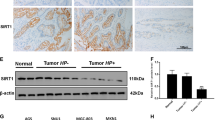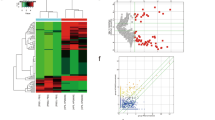Abstract
Chronic inflammation is the primary cause of gastric cancer (GC). NLRP3, as an important inflammasome component, has crucial roles in initiating inflammation. However, the potential roles of NLRP3 in GC is unknown. Here, we show that NLRP3 expression is markedly upregulated in GC, which promotes NLRP3 inflammasome activation and interleukin-1β (IL-1β) secretion in macrophages. In addition, NLRP3 binds to cyclin-D1 (CCND1) promoter and promotes its transcription in gastric epithelial cells. Consequently, NLRP3 enhances epithelial cells proliferation and GC tumorigenesis. Furthermore, we identify miR-22, which is constitutively expressed in gastric mucosa, as a suppressor of NLRP3. MiR-22 directly targets NLRP3 and attenuates its oncogenic effects in vitro and in vivo. However, Helicobacter pylori (H. pylori) infection suppresses miR-22 expression, while enhances NLRP3 expression, and that triggers uncontrolled proliferation of epithelial cells and the emergence of GC. Thus, our research describes a mechanism by which miR-22 suppresses NLRP3 and maintains homeostasis of gastric microenvironments and suggests miR-22 as a potential target for the intervention of GC.
This is a preview of subscription content, access via your institution
Access options
Subscribe to this journal
Receive 50 print issues and online access
$259.00 per year
only $5.18 per issue
Buy this article
- Purchase on Springer Link
- Instant access to full article PDF
Prices may be subject to local taxes which are calculated during checkout









Similar content being viewed by others
References
Torre LA, Bray F, Siegel RL, Ferlay J, Lortet-Tieulent J, Jemal A . Global cancer statistics, 2012. CA Cancer J Clin 2015; 65: 87–108.
Fox JG, Wang TC . Inflammation, atrophy, and gastric cancer. J Clin Invest 2007; 117: 60–69.
Hartgrink HH, Jansen EP, van Grieken NC, van de Velde CJ . Gastric cancer. Lancet 2009; 374: 477–490.
Amieva M, Peek RM Jr. . Pathobiology of Helicobacter pylori-induced gastric cancer. Gastroenterology 2016; 150: 64–78.
Castano-Rodriguez N, Kaakoush NO, Mitchell HM . Pattern-recognition receptors and gastric cancer. Front Immunol 2014; 5: 336.
Chochi K, Ichikura T, Kinoshita M, Majima T, Shinomiya N, Tsujimoto H et al. Helicobacter pylori augments growth of gastric cancers via the lipopolysaccharide-toll-like receptor 4 pathway whereas its lipopolysaccharide attenuates antitumor activities of human mononuclear cells. Clin Cancer Res 2008; 14: 2909–2917.
Allison CC, Ferrand J, McLeod L, Hassan M, Kaparakis-Liaskos M, Grubman A et al. Nucleotide oligomerization domain 1 enhances IFN-gamma signaling in gastric epithelial cells during Helicobacter pylori infection and exacerbates disease severity. J Immunol 2013; 190: 3706–3715.
Tatsuta T, Imaizumi T, Shimoyama T, Sawaya M, Kunikazu T, Matsumiya T et al. Expression of melanoma differentiation associated gene 5 is increased in human gastric mucosa infected with Helicobacter pylori. J Clin Pathol 2012; 65: 839–843.
Davis BK, Wen H, Ting JP . The inflammasome NLRs in immunity, inflammation, and associated diseases. Annu Rev Immunol 2011; 29: 707–735.
Strowig T, Henao-Mejia J, Elinav E, Flavell RI . Inflammasomes in health and disease. Nature 2012; 481: 278–286.
Petrilli V . The multifaceted roles of inflammasome proteins in cancer. Curr Opin Oncol 2017; 29: 35–40.
Allen IC, TeKippe EM, Woodford RM, Uronis JM, Holl EK, Rogers AB et al. The NLRP3 inflammasome functions as a negative regulator of tumorigenesis during colitis-associated cancer. J Exp Med 2010; 207: 1045–1056.
Wei Q, Mu K, Li T, Zhang Y, Yang Z, Jia X et al. Deregulation of the NLRP3 inflammasome in hepatic parenchymal cells during liver cancer progression. Lab Invest 2014; 94: 52–62.
Chow MT, Sceneay J, Paget C, Wong CS, Duret H, Tschopp J et al. NLRP3 suppresses NK cell-mediated responses to carcinogen-induced tumors and metastases. Cancer Res 2012; 72: 5721–5732.
van Deventer HW, Burgents JE, Wu QP, Woodford RM, Brickey WJ, Allen IC et al. The inflammasome component NLRP3 impairs antitumor vaccine by enhancing the accumulation of tumor-associated myeloid-derived suppressor cells. Cancer Res 2010; 70: 10161–10169.
Verma D, Bivik C, Farahani E, Synnerstad I, Fredrikson M, Enerback C et al. Inflammasome polymorphisms confer susceptibility to sporadic malignant melanoma. Pigment Cell Melanoma Res 2012; 25: 506–513.
Ungerback J, Belenki D, Jawad ul-Hassan A, Fredrikson M, Fransen K, Elander N et al. Genetic variation and alterations of genes involved in NFkappaB/TNFAIP3- and NLRP3-inflammasome signaling affect susceptibility and outcome of colorectal cancer. Carcinogenesis 2012; 33: 2126–2134.
Castano-Rodriguez N, Kaakoush NO, Goh KL, Fock KM, Mitchell HM . The NOD-like receptor signalling pathway in Helicobacter pylori infection and related gastric cancer: a case-control study and gene expression analyses. PloS One 2014; 9: e98899.
Semper RP, Mejias-Luque R, Gross C, Anderl F, Muller A, Vieth M et al. Helicobacter pylori-induced IL-1beta secretion in innate immune cells is regulated by the NLRP3 inflammasome and requires the cag pathogenicity island. J Immunol 2014; 193: 3566–3576.
Bartel DP . MicroRNAs: genomics, biogenesis, mechanism, and function. Cell 2004; 116: 281–297.
Calin GA, Croce CM . MicroRNA signatures in human cancers. Nat Rev Cancer 2006; 6: 857–866.
Song JH, Meltzer SJ . MicroRNAs in pathogenesis, diagnosis, and treatment of gastroesophageal cancers. Gastroenterology 2012; 143: 35–47 e32.
Bruchard M, Rebe C, Derangere V, Togbe D, Ryffel B, Boidot R et al. The receptor NLRP3 is a transcriptional regulator of TH2 differentiation. Nat Immunol 2015; 16: 859–870.
Grivennikov SI, Greten FR, Karin M . Immunity, inflammation, and cancer. Cell 2010; 140: 883–899.
Coll RC, Robertson AA, Chae JJ, Higgins SC, Muñoz-Planillo R, Inserra MC et al. A small-molecule inhibitor of the NLRP3 inflammasome for the treatment of inflammatory diseases. Nat Med 2015; 21: 248–255.
Dowling JK, O’Neill LA . Biochemical regulation of the inflammasome. Crit Rev Biochem Mol Biol 2012; 47: 424–443.
Tu S, Bhagat G, Cui G, Takaishi S, Kurt-Jones EA, Rickman B et al. Overexpression of interleukin-1beta induces gastric inflammation and cancer and mobilizes myeloid-derived suppressor cells in mice. Cancer Cell 2008; 14: 408–419.
Nam KT, Hahm KB, Oh SY, Yeo M, Han SU, Ahn B et al. The selective cyclooxygenase-2 inhibitor nimesulide prevents Helicobacter pylori-associated gastric cancer development in a mouse model. Clin Cancer Res 2004; 10: 8105–8113.
Suarez G, Romero-Gallo J, Piazuelo MB, Wang G, Maier RJ, Forsberg LS et al. Modification of Helicobacter pylori peptidoglycan enhances NOD1 activation and promotes cancer of the stomach. Cancer Res 2015; 75: 1749–1759.
Couturier-Maillard A, Secher T, Rehman A, Normand S, De Arcangelis A, Haesler R et al. NOD2-mediated dysbiosis predisposes mice to transmissible colitis and colorectal cancer. J Clin Invest 2013; 123: 700–711.
Karki R, Man SM, Malireddi RK, Kesavardhana S, Zhu Q, Burton AR et al. NLRC3 is an inhibitory sensor of PI3K-mTOR pathways in cancer. Nature 2016. PMID: 27951586.
Yoshihama S, Roszik J, Downs I, Meissner TB, Vijayan S, Chapuy B et al. NLRC5/MHC class I transactivator is a target for immune evasion in cancer. Proc Natl Acad Sci USA 2016; 113: 5999–6004.
Hu B, Elinav E, Huber S, Booth CJ, Strowig T, Jin C et al. Inflammation-induced tumorigenesis in the colon is regulated by caspase-1 and NLRC4. Proc Natl Acad Sci USA 2010; 107: 21635–21640.
Huai W, Zhao R, Song H, Zhao J, Zhang L, Zhang L et al. Aryl hydrocarbon receptor negatively regulates NLRP3 inflammasome activity by inhibiting NLRP3 transcription. Nat Commun 2014; 5: 4738.
Yan Y, Jiang W, Liu L, Wang X, Ding C, Tian Z et al. Dopamine controls systemic inflammation through inhibition of NLRP3 inflammasome. Cell 2015; 160: 62–73.
Song H, Liu B, Huai W, Yu Z, Wang W, Zhao J et al. The E3 ubiquitin ligase TRIM31 attenuates NLRP3 inflammasome activation by promoting proteasomal degradation of NLRP3. Nat Commun 2016; 7: 13727.
Guo C, Xie S, Chi Z, Zhang J, Liu Y, Zhang L et al. Bile acids control inflammation and metabolic disorder through inhibition of NLRP3 inflammasome. Immunity 2016; 45: 802–816.
Bauernfeind F, Rieger A, Schildberg FA, Knolle PA, Schmid-Burgk JL, Hornung V . NLRP3 inflammasome activity is negatively controlled by miR-223. J Immunol 2012; 189: 4175–4181.
Haneklaus M, Gerlic M, Kurowska-Stolarska M, Rainey AA, Pich D, McInnes IB et al. Cutting edge: miR-223 and EBV miR-BART15 regulate the NLRP3 inflammasome and IL-1beta production. J Immunol 2012; 189: 3795–3799.
Yang F, Hu Y, Liu HX, Wan YJ . MiR-22-silenced cyclin A expression in colon and liver cancer cells is regulated by bile acid receptor. J Biol Chem 2015; 290: 6507–6515.
Wan WN, Zhang YQ, Wang XM, Liu YJ, Zhang YX, Que YH et al. Down-regulated miR-22 as predictive biomarkers for prognosis of epithelial ovarian cancer. Diagn Pathol 2014; 9: 178.
Xu D, Takeshita F, Hino Y, Fukunaga S, Kudo Y, Tamaki A et al. miR-22 represses cancer progression by inducing cellular senescence. J Cell Biol 2011; 193: 409–424.
Pasqualini L, Bu H, Puhr M, Narisu N, Rainer J, Schlick B et al. miR-22 and miR-29a are members of the androgen receptor cistrome modulating LAMC1 and Mcl-1 in prostate cancer. Mol Endocrinol 2015; 29: 1037–1054.
Zuo QF, Cao LY, Yu T, Gong L, Wang LN, Zhao YL et al. MicroRNA-22 inhibits tumor growth and metastasis in gastric cancer by directly targeting MMP14 and Snail. Cell Death Dis 2015; 6: e2000.
Wang X, Yu H, Lu X, Zhang P, Wang M, Hu Y . MiR-22 suppresses the proliferation and invasion of gastric cancer cells by inhibiting CD151. Biochem Biophys Res Commun 2014; 445: 175–179.
Lu H, Ouyang W, Huang C . Inflammation, a key event in cancer development. Mol Cancer Res 2006; 4: 221–233.
Lamb A, Chen LF . Role of the Helicobacter pylori-induced inflammatory response in the development of gastric cancer. J Cell Biochem 2013; 114: 491–497.
El-Omar EM, Carrington M, Chow WH, McColl KE, Bream JH, Young HA et al. Interleukin-1 polymorphisms associated with increased risk of gastric cancer. Nature 2000; 404: 398–402.
Hai Ping P, Feng BoT, Li L, Nan Hui Y, Hong Z . IL-1beta/NF-kb signaling promotes colorectal cancer cell growth through miR-181a/PTEN axis. Arch Biochem Biophys 2016; 604: 20–26.
Qin Y, Milton DR, Oba J, Ding Z, Lizee G, Ekmekcioglu S et al. Inflammatory IL-1beta-driven JNK activation in stage III melanoma. Pigment Cell Melanoma Res 2015; 28: 236–239.
Karin M . Nuclear factor-kappaB in cancer development and progression. Nature 2006; 441: 431–436.
Wagner EF, Nebreda AR . Signal integration by JNK and p38 MAPK pathways in cancer development. Nat Rev Cancer 2009; 9: 537–549.
Huai W, Song H, Yu Z, Wang W, Han L, Sakamoto T et al. Mint3 potentiates TLR3/4- and RIG-I-induced IFN-beta expression and antiviral immune responses. Proc Natl Acad Sci USA 2016; 113: 11925–11930.
Acknowledgements
This work was supported by the National Natural Science Foundation of China (Nos. 81772151, 81571960, 81371781, 81670146, 81470318, 81372680, 81471991 and 81501720), the Science Foundation of Shandong Province (2017GSF18194, 2017GSF18109, 2014GSF118114 and ZR2014HQ070), and the Independent Innovation Foundation of Shandong University.
Author contributions
JJ conceived of the study and provided overall direction; SL, WZ and JJ designed the experiments; SL, XL, LM, LS, TL, LZ, AS, WS and CC performed the experiments; SL, WZ and JJ analyzed the data and wrote the paper.
Author information
Authors and Affiliations
Corresponding authors
Ethics declarations
Competing interests
The authors declare no conflict of interest.
Additional information
Supplementary Information accompanies this paper on the Oncogene website
Supplementary information
Rights and permissions
About this article
Cite this article
Li, S., Liang, X., Ma, L. et al. MiR-22 sustains NLRP3 expression and attenuates H. pylori-induced gastric carcinogenesis. Oncogene 37, 884–896 (2018). https://doi.org/10.1038/onc.2017.381
Received:
Revised:
Accepted:
Published:
Issue Date:
DOI: https://doi.org/10.1038/onc.2017.381
This article is cited by
-
Mechanisms and effects of NLRP3 in digestive cancers
Cell Death Discovery (2024)
-
Harnessing innate immune pathways for therapeutic advancement in cancer
Signal Transduction and Targeted Therapy (2024)
-
The ‘speck’-tacular oversight of the NLRP3-pyroptosis pathway on gastrointestinal inflammatory diseases and tumorigenesis
Journal of Biomedical Science (2023)
-
The E3 ubiquitin ligase TRIM31 attenuates NLRP3 inflammasome activation in Helicobacter pylori-associated gastritis by regulating ROS and autophagy
Cell Communication and Signaling (2023)
-
NR1D1 deficiency in the tumor microenvironment promotes lung tumor development by activating the NLRP3 inflammasome
Cell Death Discovery (2023)



